Home › Forums › The Industrial Era › The Spuyten Duyvil and Port Morris Railroad – Part 1: Men Behaving Badly
- This topic has 0 replies, 1 voice, and was last updated 4 years, 11 months ago by
 ndembowski.
ndembowski.
-
AuthorPosts
-
-
August 4, 2019 at 10:51 pm #1085
While researching a completely different topic in the Yonkers Statesman Newspaper in the 1870s, I ended up learning quite a bit about the construction of the Spuyten Duyvil and Port Morris Railroad. Both its layout and construction were extremely disruptive, or perhaps even traumatic, to the growing neighborhood of Kingsbridge–then part of Yonkers.
The first mention I came across appears in the June 17, 1870 edition of the Statesman:
 News for this neighborhood always appeared under the heading “Kingsbridgeville” as that was the designation of the local post office, which, coincidentally, was operated by the same Dwight E. Webb whose new grocery wagon is referred to above. I would not be completely surprised if Mr. Webb was the Kingsbridge correspondent for the paper. Nevertheless, if you are familiar with the topography of the area, you can see why this portion of the railroad that ran through the Spuyten Duyvil/Kingsbridge area would be challenging.
News for this neighborhood always appeared under the heading “Kingsbridgeville” as that was the designation of the local post office, which, coincidentally, was operated by the same Dwight E. Webb whose new grocery wagon is referred to above. I would not be completely surprised if Mr. Webb was the Kingsbridge correspondent for the paper. Nevertheless, if you are familiar with the topography of the area, you can see why this portion of the railroad that ran through the Spuyten Duyvil/Kingsbridge area would be challenging.To get from the eastern bank of the Hudson to the Harlem would entail building a causeway over part of the Spuyten Duyvil Creek, blasting through Spuyten Duyvil Hill, stabilizing the bank of Tibbetts Brook, building a bridge over Tibbetts Brook, blasting through the rock below modern day 231st Street, and completing the rest of the 14 mile stretch of the railroad. Not to mention, pedestrian crossings and stations would need to be built as this was going through a populated area.
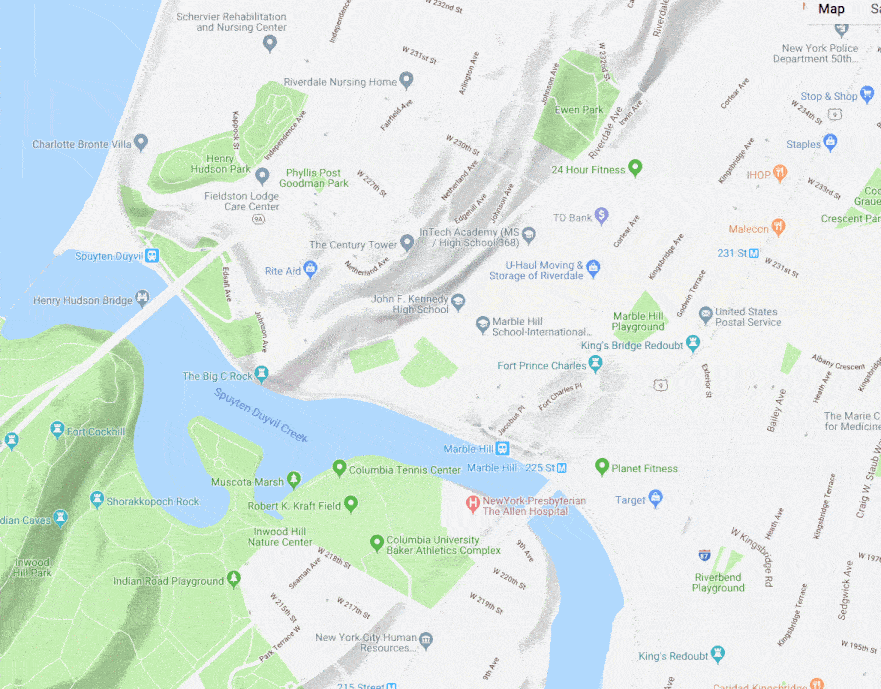
By the time the above portion of the line was built, the SD&PM RR was a subsidiary of the New York Central, which had the Vanderbilt money needed to invest in such an undertaking.
It is hard to know what had a greater impact on the neighborhood, the rock blasting or the presence of the workers themselves. The number of railroad workers in the area numbered in the high hundreds and possibly even higher. The situation is reminiscent of the hundreds of patriot soldiers that came from afar to fortify Kingsbridge in 1776. In those days Washington was forced to issue orders to limit drinking and forbid “plundering” the local inhabitants. However, unlike Washington, the foremen of the Spuyten Duyvil and Port Morris Railroad did not have the threats of court martial or execution to enforce good behavior.
Labor was cheap in the 1870s. There were all of the jobless veterans of the Civil War, a massive influx of Irish and German immigrants, plus the formerly enslaved Black population making the Great Migration to the New York area. The first signs of trouble appear in the July 7, 1870 edition of the Statesman.
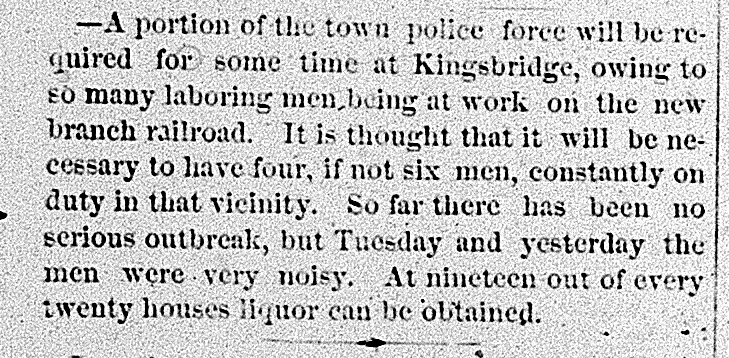 The drinking establishments were certainly a well-known feature of Kingsbridge, which, even before the railroad, was home to the rough-and-tumble foundrymen employed at either the Johnson Foundry, the Spuyten Duyvil Rolling Mill, or the Langdon Rolling Mill. But the additional presence of the railroad workers seemed to only add to the “rowdiness” of the neighborhood (from the 7/14/1870 Statesman):
The drinking establishments were certainly a well-known feature of Kingsbridge, which, even before the railroad, was home to the rough-and-tumble foundrymen employed at either the Johnson Foundry, the Spuyten Duyvil Rolling Mill, or the Langdon Rolling Mill. But the additional presence of the railroad workers seemed to only add to the “rowdiness” of the neighborhood (from the 7/14/1870 Statesman):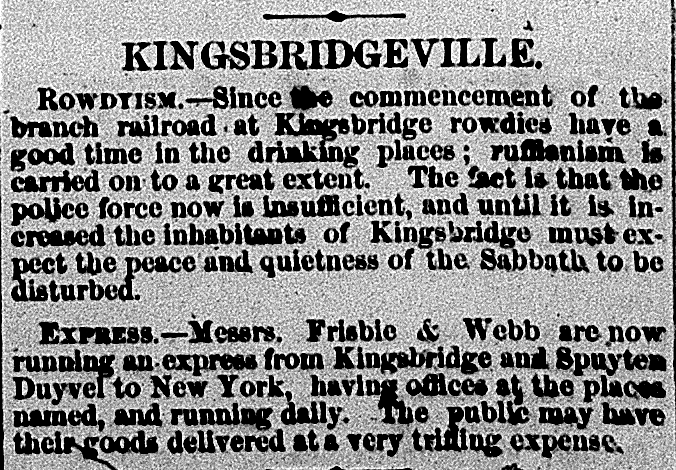 However, not everyone was content to scapegoat the railroad workers as one reader of the Statesman pointed out in the following issue:
However, not everyone was content to scapegoat the railroad workers as one reader of the Statesman pointed out in the following issue: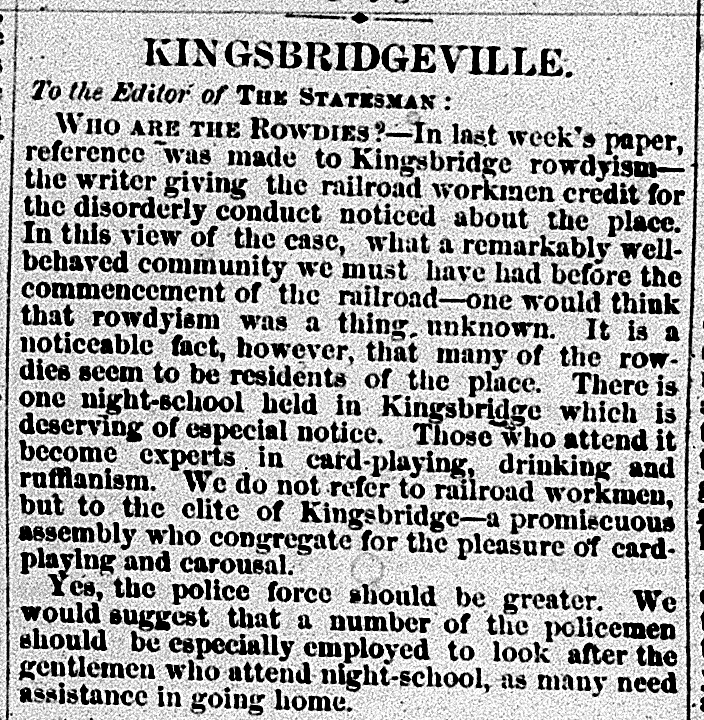
This led to a bit of a back-and-forth in the paper as this appeared in the following week’s edition:
 Transcription:
Transcription:Night School – Your correspondent, with much apparent complacency, attempts to lay the blame entirely upon the elite of Kingsbridge. The…
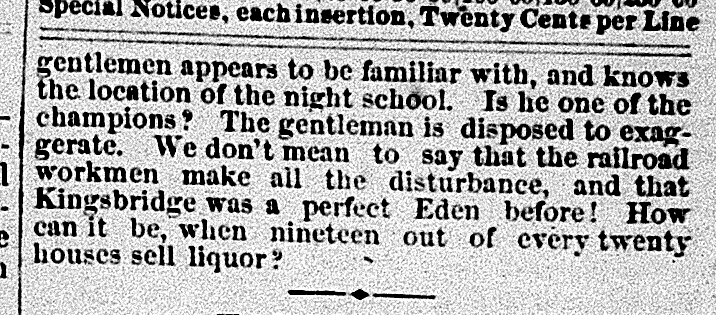 gentlemen appears to be familiar with, and knows the location of the night school. Is he one of the champions? The gentleman is disposed to exaggerate. We don’t mean to say that the railroad workmen make all the disturbance, and that Kingsbridge was a perfect Eden before! How can it be, when nineteen out of every twenty houses sell liquor?
gentlemen appears to be familiar with, and knows the location of the night school. Is he one of the champions? The gentleman is disposed to exaggerate. We don’t mean to say that the railroad workmen make all the disturbance, and that Kingsbridge was a perfect Eden before! How can it be, when nineteen out of every twenty houses sell liquor?Bad behavior due to excessive alcohol was nothing new in the area. Even before the workers showed up, stories like this could be commonly found:
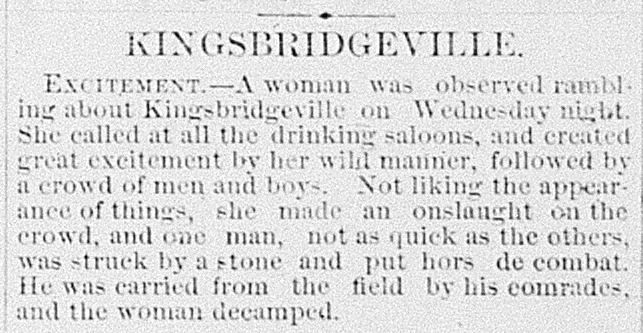
But there was certainly an uptick in “ruffianism” with the arrival of the workers. And we are not just talking about card playing, bottle breaking, and making noise. Burglary was on the rise and there are many versions of the below story in the paper:
 But it gets much worse with stories of acts of violence becoming more common (8/4/1870 Statesman):
But it gets much worse with stories of acts of violence becoming more common (8/4/1870 Statesman):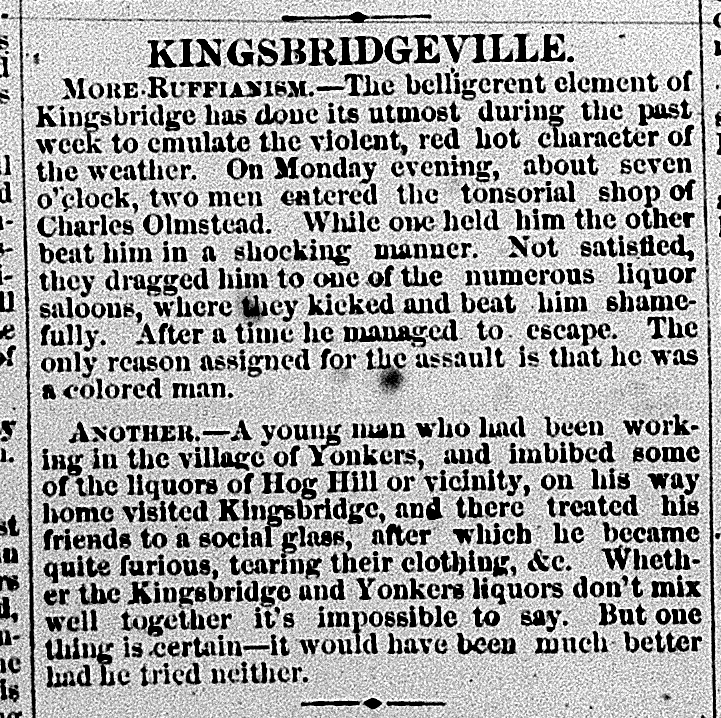
The neighborhood responded. Seeing the destructive effects of alcohol on the neighborhood, the Sons of Temperance (a society akin to today’s Alcoholics Anonymous) committed to fighting insobriety in the neighborhood. This is from the September 30, 1870 of the Statesman:
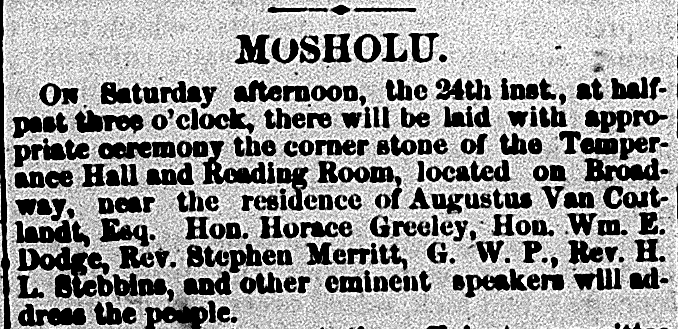
The Temperance Hall was built just north of today’s W. 242nd Street train station on Broadway where today’s Post Road and Manhattan College Parkway meet (around where there is a Burger King now). That intersection was the home of the neighborhood of Mosholu. The Temperance Hall is labeled “Public Hall” in the below 1873 map. You can see the Van Cortlandt House in today’s Van Cortlandt Park on the right.
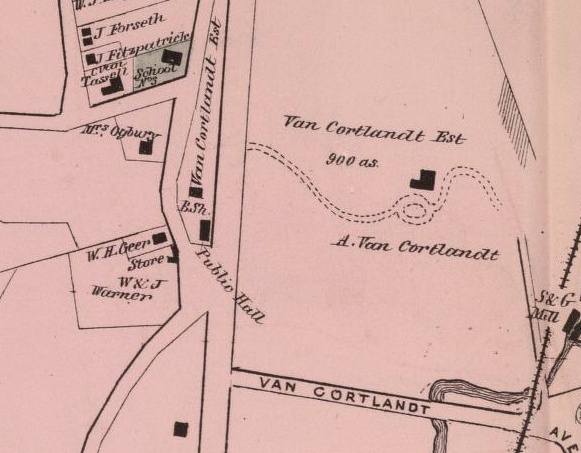 An earlier article mentioned the high temperatures of the summer. That was not the only thing that the workers had to be perturbed about. They were also getting their wages cut. This led to a strike in the middle of construction:
An earlier article mentioned the high temperatures of the summer. That was not the only thing that the workers had to be perturbed about. They were also getting their wages cut. This led to a strike in the middle of construction: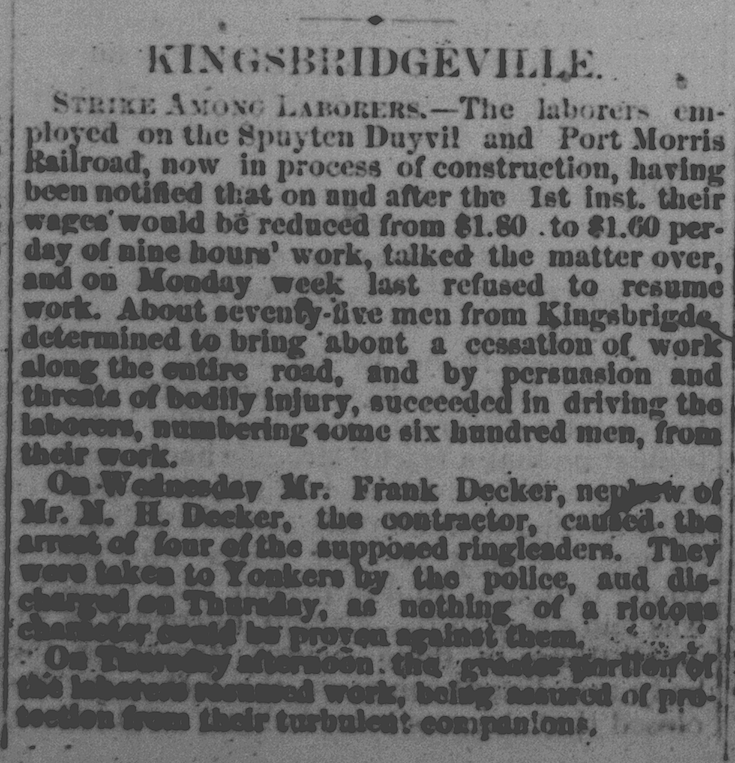
Transcription:
“Strike Among Laborers.–The laborers employed on the Spuyten Duyvil and Port Morris Railroad, now in process of construction, having been notified that on and after the 1st inst. their wages would be reduced from $1.80 to $1.60 per day of nine hours’ work, talked the matter over, and on Monday week last refused to resume work. About seventy-five men from Kingsbridge, determined to bring about a cessation of work along the entire road, and by persuasion and threats of bodily injury, succeeded in driving the laborers, numbering some six hundred men, from their work.
On Wednesday Mr. Frank Decker, nephew of Mr. M H Decker, the contractor, caused the arrest of four of the supposed ringleaders. They were taken to Yonkers by the police, and discharged on Thursday, as nothing of a riotous character could be proven against them.
On Thursday afternoon the greater portion of the laborers resumed work, being assured of protection from their turbulent companions.”
Nonetheless, the strike, the drinking, the burglary, and the rowdiness persisted well into 1871. This snapshot from March says it all:
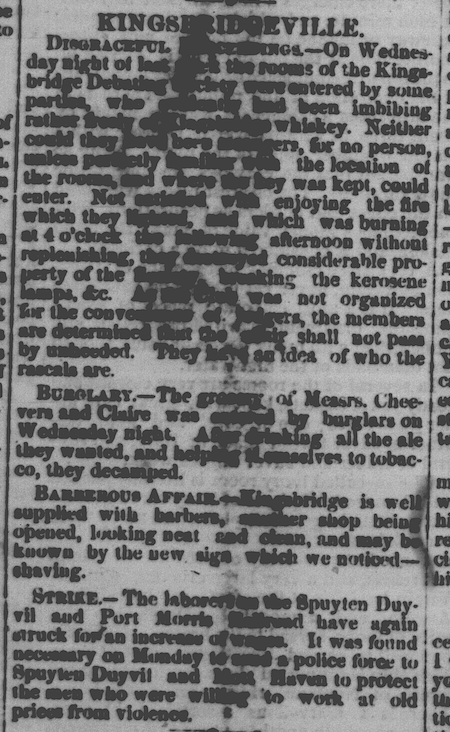
Transcription:
“Disgraceful Proceedings – On Wednesday night of last week the rooms of the Kingsbridge Debating Society were entered by some parties, who evidently had been imbibing rather freely of Kingsbridge whiskey. Neither could they have been strangers, for no person unless perfectly familiar with the location of the room, and where the key was kept, could enter. Not satisfied with enjoying the fire which they lighted, and which was buring at 4 o’clock the following afternoon without replenishing, they destroyed considerable property of the Society, breaking the kerosene lamps, etc. As the Club was not organized for the convenience of [illegible], the members are determined that the affair shall not pass by unheeded. They have an idea of who the rascals are.
Burglary – The grocery of Messrs. Cheevers and Claire was entered by burglars on Wednesday night. After drinking all the ale they wanted, and helping themselves to tobacco, they decamped. . .
Strike – The laborers of the Spuyten Duyvil and Port Morris Railroad have again struck for an increase of wages . . . It was found necessary on Monday to send a police force to Spuyten Duyvil and Mott Haven to protect the men who were willing to work at old prices from violence.”
Perhaps this comes as no surprise:
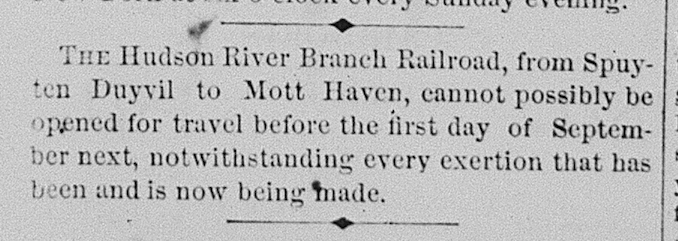
In the next part, I will write about the other more explosive and deadly effects on the neighborhood stemming from this railroad. To be continued…
-
-
AuthorPosts
- You must be logged in to reply to this topic.